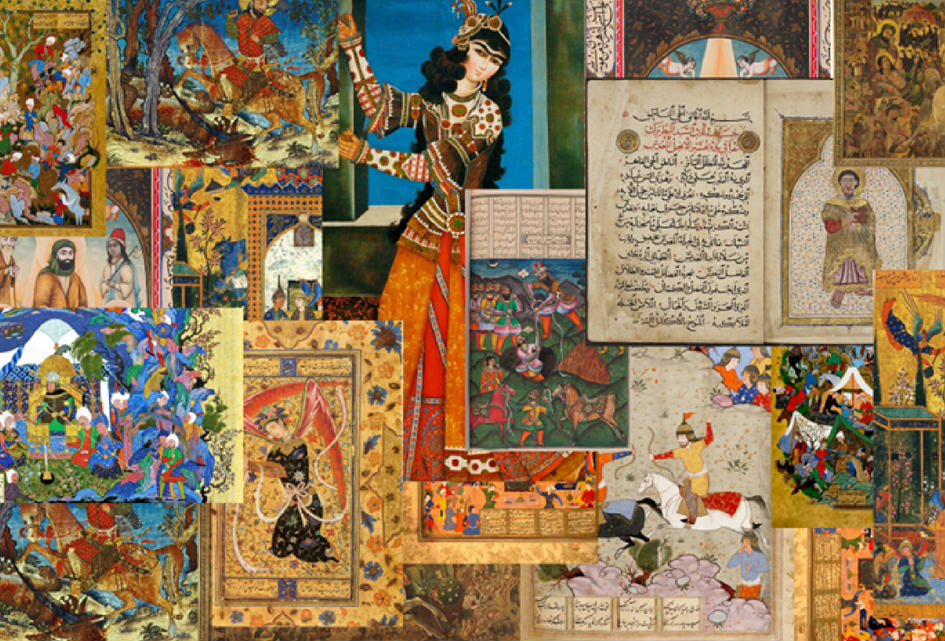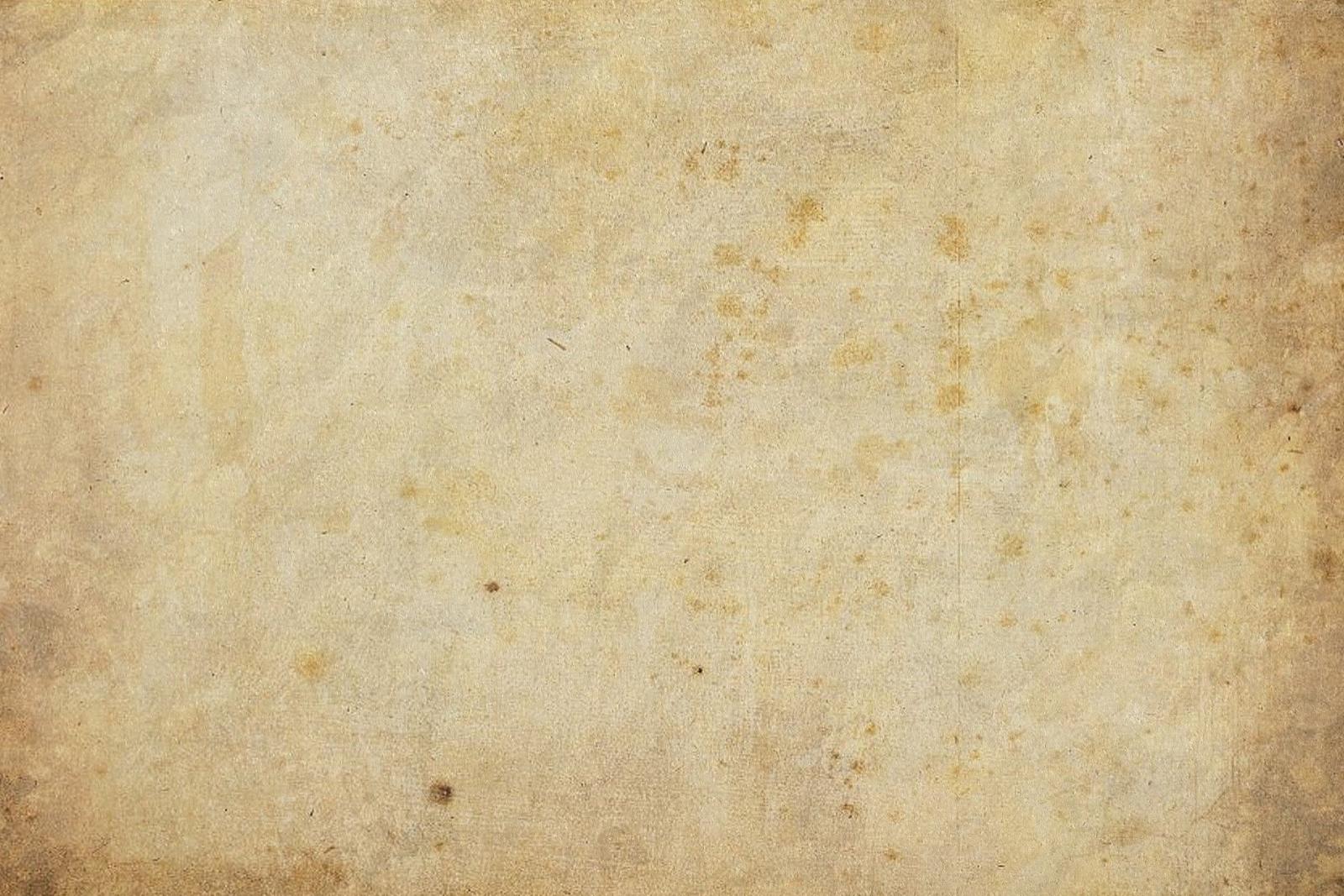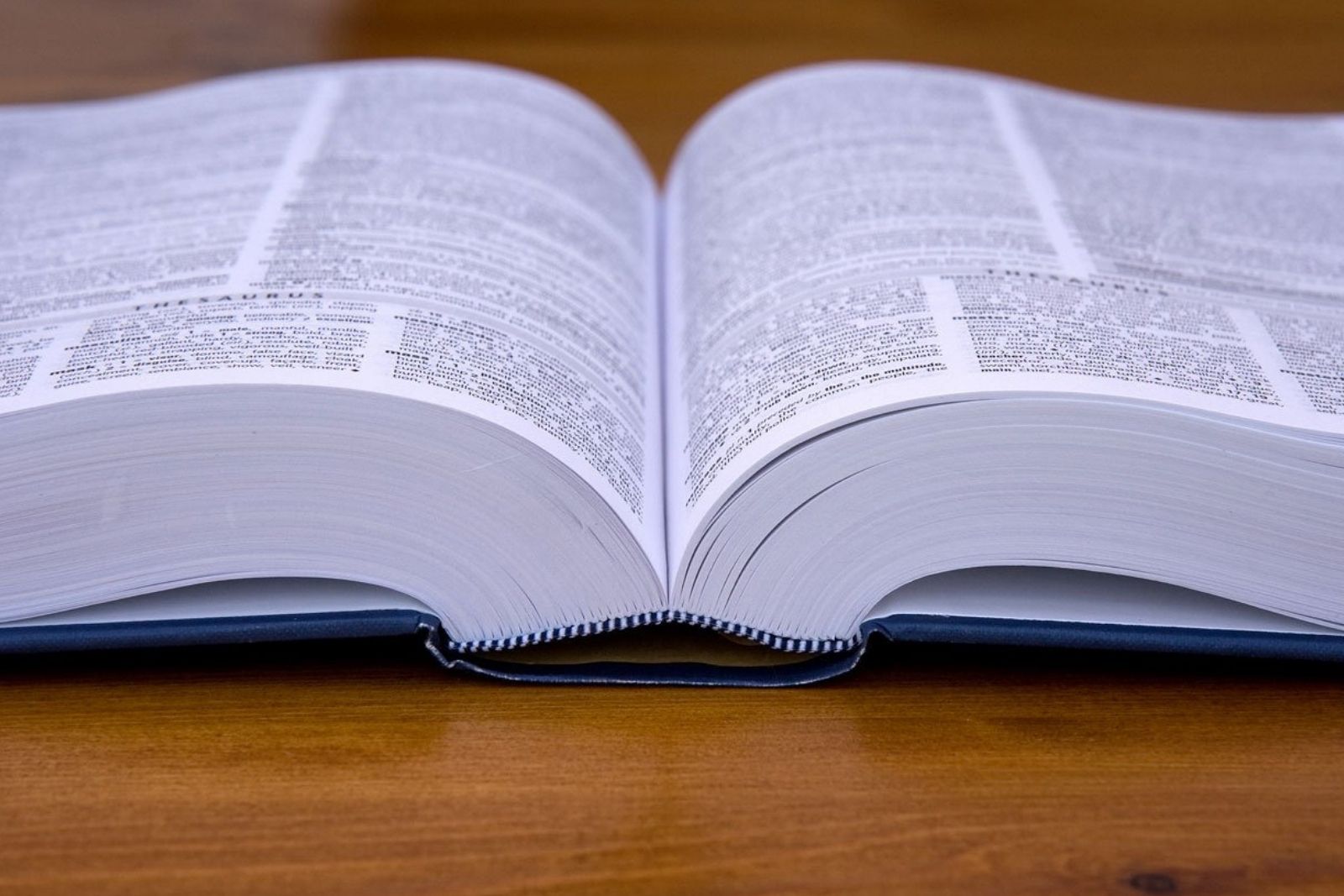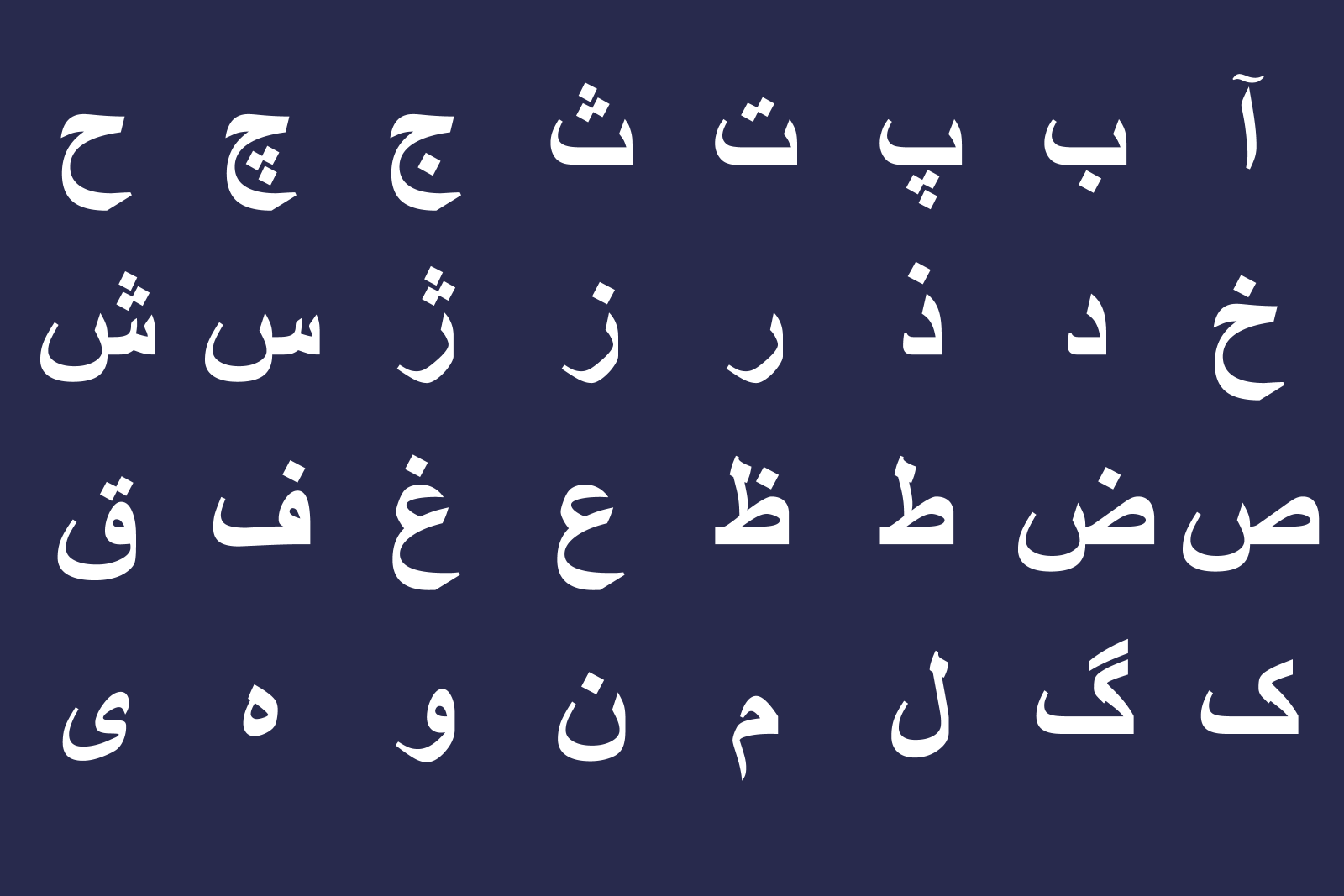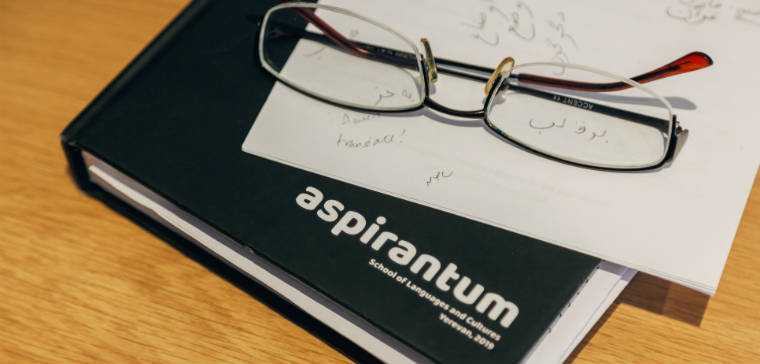Persian - or Farsi - is spoken in the Islamic Republic of Iran, Afghanistan (Dari) and Tajikistan (Tajiki).
Today, more than 120 million people speak Persian as their first or second language. By the number of its speakers and its influence, it is the most widespread language in the Middle East along with Arabic. Major news broadcasters, like BBC, DW or Euronews, have Persian-language services.
However, having studied Persian for years, I can assure you that the importance of this language goes way beyond its political significance.
Persian is a language with an extremely rich history, literature and cultural tradition. Besides its huge impact on modern literature, Persian has its own prominent place in poetry. Khayyam, Sa’di and Hafiz are only a few of the major figures of this big family.
The first attestations of Persian go back to around 500 BC. Since then it has played an important role in the history of the lands between the Mediterranean Sea and India.
Below, you can read about its history, literature and significance.
The origin of the name “Persian”.
Where is the place of Persian on the linguistic map?
Where is Persian/Farsi spoken?
History of the Persian language.
Three stages of Persian: Old, Middle, New.
How do we know about Old Persian?
What other important Old Persian inscriptions do we have?
The royal inscriptions of the Sassanids.
Zoroastrian Literature in Middle Persian/Pahlavi.
Middle Persian vs New Persian.
New Persian - Language of Iran.
Beginnings of the New Persian literature.
The difference between Early and Late New Persian.
Persian before the Modern period.
Literary or Vernacular Persian.
Why is it called “Persian”?
Many modern words and ideas which we are used to call our own were indeed shaped in Classical Greece. The word “Persia” is one of those. 2500 years ago, the Greeks had their first contact with the Persians.
At that time the Persians were at the head of a huge empire that stretched from Greece to India, and from the Caspian Sea to the Persian Gulf. This empire (Achaemenid Empire), during its expansion westwards, eventually came across the Greeks. We all know what happened next.
Besides having tremendous political and cultural implications, the Graeco-Persian wars were also reflected upon in the Greek literature. Aeschylus, one of the three famous classical Greek playwrights, dedicated one of his tragedies to the Greek victory at Salamis. He entitled this tragedy, “The Persians” or Πέρσαι (Persai) in Greek.
Following him was the “father of history”, Herodotus who freely used this name in his “Histories”. Since then, it continued to be extensively used and later was borrowed by the Romans, and, through Latin (the language of religion and science in Medieval Europe) penetrated into English.
The origin of the name “Persian”
It was from the Persians themselves that the Greeks took the word πέρσαι (persai). Persians - as we learn from the Achaemenid royal inscriptions - called themselves “pārsa”. This is how Darius I, the Great King of the Persians (522-486 BC), describes himself (DNa, § 2):
adam Dārayavauš xšāyaθiya vazṛka … Vištāspahyā puça, Haxāmanišiya, Pārsa, Pārsahyā puça, Ariya, Ariyaciça.
I, Darius, the Great King … the son of Vištāspa, an Achaemenid, a Persian, son of a Persian, an Aryan, of Aryan descent.
But where did the Persians come from? The Persians were a tribe or a confederation of tribes who lived on the western and southern slopes of the Zagros mountains (in the west of modern Iran) in the first half of the 1st millennium BC.
The first written attestation of their name comes from Assyrian royal inscriptions (Shalmaneser III, 858-824 BC.), where they are called “pár-su-a”.
Later, when the political significance of the Persian tribes increased, their name became widely known.
Persian or Farsi?
When Firdawsi - the famous author of the Persian epic - was writing his magnificent Shāhnāme or, the “Book of Kings”, the Persians called their language “Dari” (‘[the language] of the court’) or “Pārsī” (a later form of the earlier “Pārsīg”).
Later, people in Iran started using the Arabized form of the second name (“Pārsī”), which was pronounced “fārsi” (because in Arabic there was no ‘p’ sound). Today, in Iran, they continue to use this version. However, in the English tradition, the language has been called “Persian” - the language of Persia.
In the mid-20th century, the official languages in Afghanistan and Tajikistan - being variations of Persian - were officially renamed Dari and Tajiki.
After this, some English speakers started using the name “Farsi” instead of “Persian”.
This was done in order to distinguish the Persian of Iran from the “Persian” of Afghanistan (Dari) and Tajikistan (Tajiki).
But this is rather unnecessary. Since the names Dari and Tajiki are already being used in Afghanistan and Tajikistan to refer to local “Persian”, there is no need to use the name “Farsi” instead of Persian for the language of Iran.
Recently, the Academy of the Persian Language and Literature officially rejected the use of the name “Farsi” instead of “Persian”.
Where is the place of Persian on the linguistic map?
Persian is an Iranian language, actually one of many Iranian languages and dialects, albeit a very prominent one.
In their turn, Iranian languages are closer to the Indo-Aryan languages. Together, they comprise the Indo-Iranian branch of the Indo-European language family. You have probably heard about this language family, either in school or in college.
English, French, Russian, Greek, Armenian, Hindu, Albanian, Croatian and dozens of other languages also belong to this same language family.
If you are not familiar with linguistics, let me explain how this works and what it means.
When we say that a certain number of languages belong to the X language family, it means that at a certain point in history, probably a couple of thousand years ago, they were the same language.
Through the passage of time, a number of dialects arose from that “proto-language”. Later, when those dialects became independent languages, new dialects started developing from those and so on and so forth…
Thus from one Proto-Indo-European language, other languages developed, including Persian.
Besides Persian, there are many other Iranian languages that you might have heard of. Those are Kurdish, Pashto, Balochi, Ossetic, Talyshi, etc.
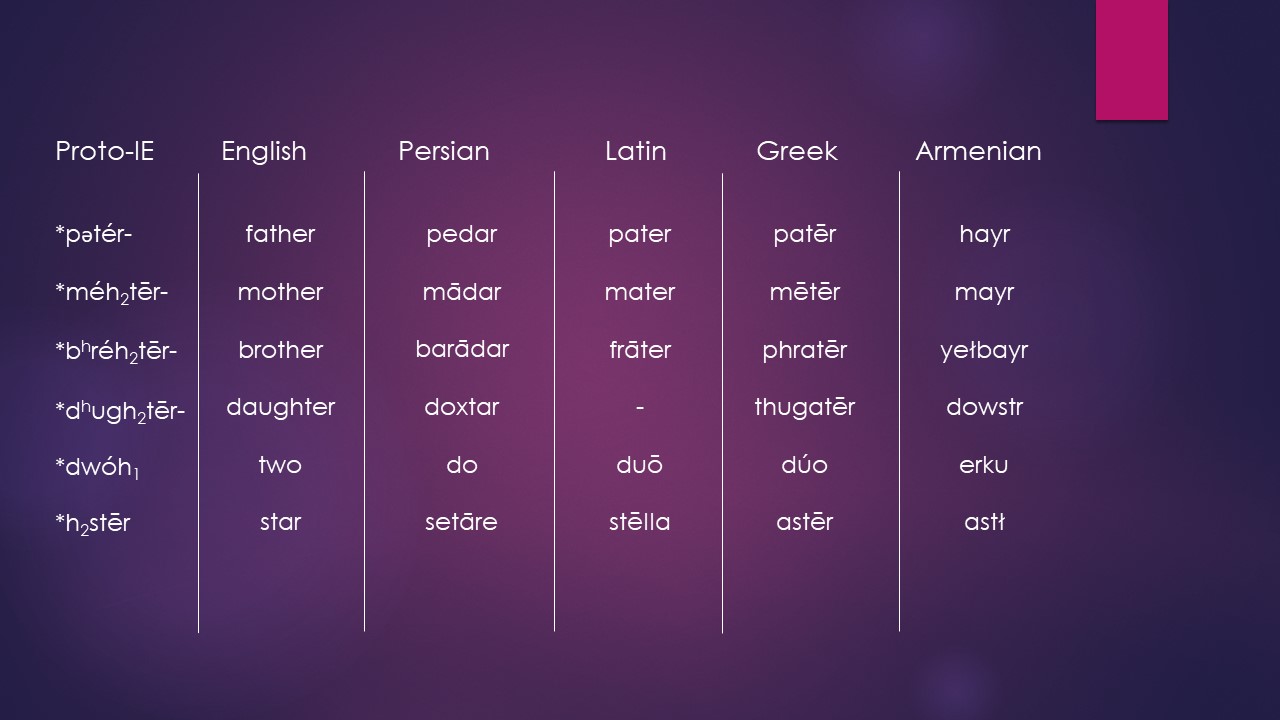
Where is Persian/Farsi spoken?
Today, three countries recognize Persian as their state language: the Islamic Republic of Iran, Afghanistan and Tajikistan.
The territory covered by its speakers is approximately 2,500,000 sq. km. To imagine how big it is, put France, Spain, Germany, Italy, Great Britain and Norway together, and you will approach that number.
A significant number of speakers of Tajiki Persian also live in Uzbekistan (4.4% of its total population).
Large Iranian communities exist abroad, in countries like the USA, Germany, Sweden or Canada.
In Afghanistan, Dari Persian, besides serving as the lingua franca for its multi-ethnic population, is also the first language of the majority of people.
In Iran, Persian is known by the absolute majority of the population and serves as the state language for interethnic and state communication.
In the past, some three or four hundred years ago, the usage of Persian was even more widespread. It served as a lingua franca in the east at the court of the Mughal emperors and in the west at the courts of the Ottoman sultans.
History of the Persian language
Everything has a history, and languages are no exception. In fact, languages constantly change, and the study of that change is what the history of languages is all about. The same language which was spoken not more than a thousand years ago, becomes unintelligible to new speakers.
Iranian languages in general, and Persian in particular, have a very rich history. In this section, we will get a closer look at the history of its development.
Is Persian an old language?
It may sound shocking, but there is no such a thing as old or new languages.
Languages are constantly changing, or rather developing into new languages. They are not born, like humans, but gradually grow out of their predecessors. Simply, all languages are as old as the ability of humans to speak.
However, don’t panic! There is still something to compete over. Some languages are historically more “traceable” than others.
If, by saying “old language”, we understand a language that has an old literary tradition, then yes, Persian is a very old language.
Thus, besides having a thousand-year-old exquisitely refined literature in New Persian, Persian has an even longer literary tradition. The epigraphic texts in which this language is first attested date back to 2500 years ago.
Three stages of Persian: Old, Middle, New.
You may have heard the Latin proverb which says “Divide et Impera”, i.e. “Divide and Rule”. For our purposes, we can rephrase it: “Divide and study”. Applying this method to our case, we divide the long history of Persian into three periods: Old, Middle and New.
Old Persian was spoken sometime between the 6th and 4th centuries BC. It was used in the royal inscriptions of the Achaemenid kings (and in at least one administrative text).
Middle Persian was generally spoken from the beginning of our era to sometime in the 8th c. AD. We have a comparatively rich religious and also some sparse secular literature written in this language.
The New Persian period starts in the 9th/10th centuries and continues to develop up until today. We have a very rich literary tradition in this language.
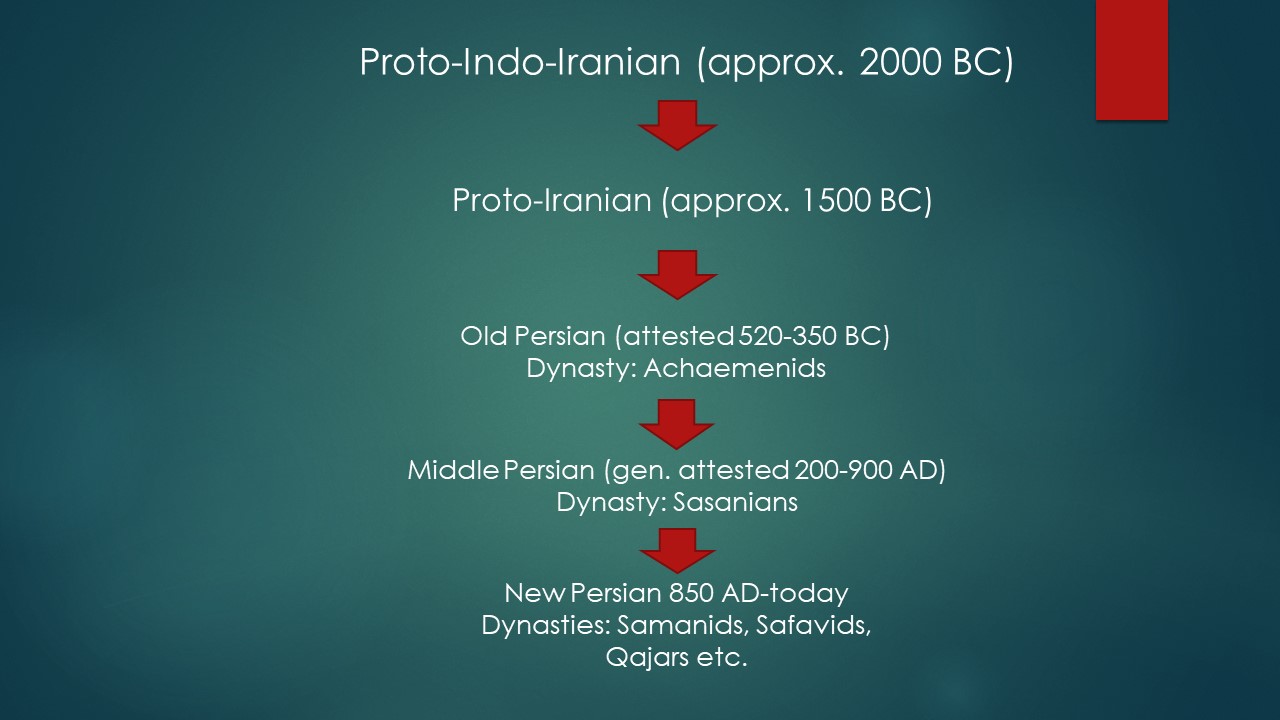
Old Persian
Remember the Hollywood movie “300”? Can you recall the vilified character of Xerxes, who tried to conquer the peaceful and freedom-loving Spartans?
Have you ever read the Bible? You probably remember the praised character of Cyrus the Great, who liberated the Jews from the Babylonian Captivity, and helped them rebuild the Temple.
If that’s not enough, open the history books of Ancient Greece or Mesopotamia, and you will find the names of the Great Kings of the Persians repeated many times.
These kings belong to one dynasty, which in today’s Western scholarly tradition is called “Achaemenid”. They called themselves Haxāmanišiya and spoke Old Persian.
Achaemenids built a strong empire on the ruins of the Median, Babylonian and Lydian states. They commemorated their achievements by building magnificent palaces and writing inscriptions.
Being Persian by origin, these kings chose to write their inscriptions in their own language, Old Persian.
How do we know about Old Persian
Since Marco Polo, many European travelers have crossed the vast expanses of Iran. Many of them kept diaries and later published their books.
During their journeys, many of those travelers saw the striking monuments left from the Achaemenid period, including Persepolis, the capital of Darius I.
When they came back, they brought with them the copies of a strange wedge-shaped writing, which had never been seen before by the Western Europeans.
In the mid-19th century, a number of scholars, the first of whom was Henry Creswicke Rawlinson, deciphered this script that was used to write Old Persian and learned from them about the famous rivals of the Greeks, the Achaemenid kings.
Gradually, many more inscriptions were found in Iran, Egypt, Armenia, etc.
Inscriptions in Old Persian
The Achaemenid kings, when they accomplished ‘great deeds’ (at least in their view) - like achieving military victories, building large palaces, or digging deep canals - left inscriptions in cuneiform script using their native tongue.
The word cuneiform in English has a Latin origin, the first part of which comes from the Latin cuneus, meaning “wedge”.
Every character in this script consists of wedge-shaped small signs, arranged together in different positions, each one of which stands for a certain sound or two sounds.
Other cuneiform scripts also existed, and were used to write many languages, including Akkadian, Elamite and Urartian. The difference between these and the Old Persian script, is that the latter is closer to an alphabetic system of writing.
There are dozens of Achaemenid royal inscriptions in Iran, most of which have similar contents.
The most extensive and important inscription is the one inscribed on Mount Behistun near Kermanshah.
After his accession to the throne of the Empire and the suppression of an impressive amount of rebellions, Darius I ordered the creation of this inscription to commemorate his victories. He enumerates in it the lands in which the rebellions took place, the names of the rebel leaders and describes the battles in which he defeated them.
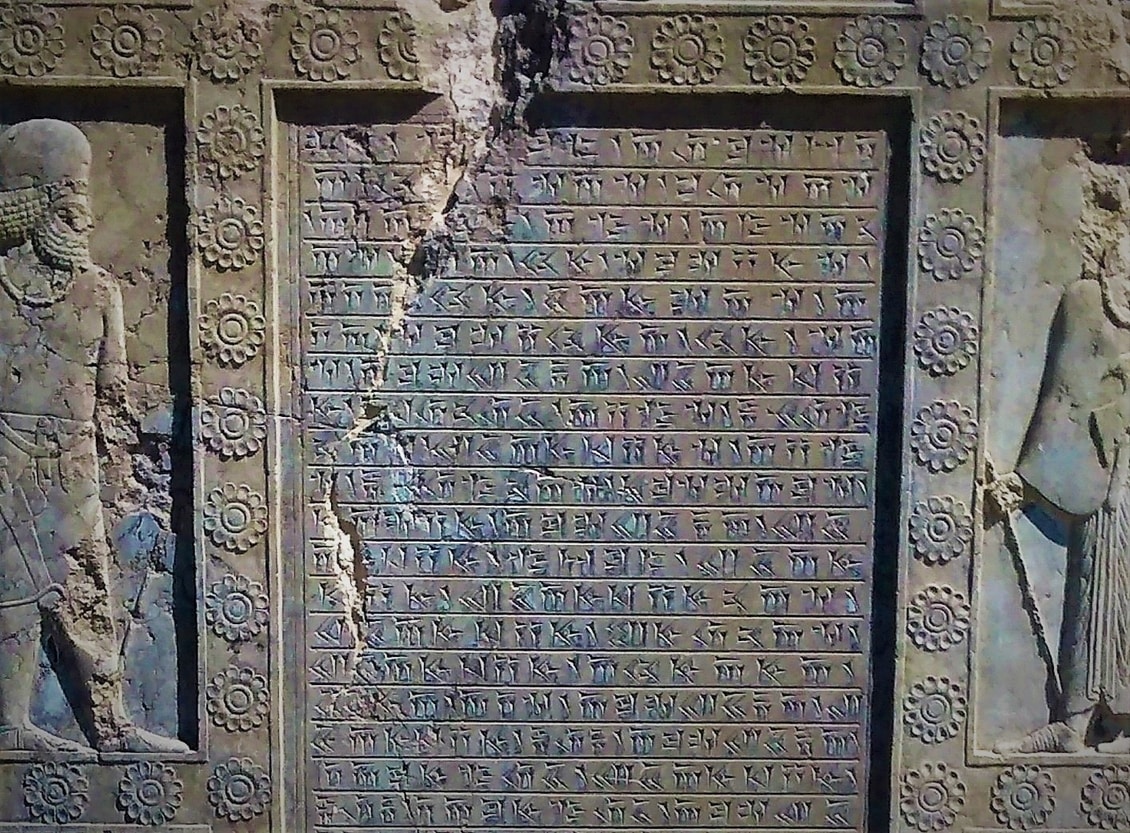
What other important Old Persian inscriptions do we have?
After Darius’ Behistun inscription (DB) and many other inscriptions, his successors continued this tradition. In contrast to their predecessor, these kings generally lacked the creative spark that Darius I possessed.
There are inscriptions left by Xerxes I, Artaxerxes I, Darius II and others. Most of these are found in Persepolis (the ceremonial capital of the Achaemenid Empire), Pasargadae, Susa and Hamadan.
The contents of the majority of these inscriptions are overall very primitive and often contain nothing more than the titulary of the king and the list of the lands under their dominion. It is no surprise that the vocabulary of Old Persian that has reached us does not exceed 600 words.
To give you an understanding of what an average inscription looks like, I will analyze the structure of one of Xerxes’ inscriptions (XPa) below.
It starts with the praise of Ahura Mazda, the great god in Zoroastrianism: “A great god is Ahura Mazda, who has created this Earth, who has created that Sky … who has made Xerxes a king”.
Then the king presents himself: “I am Xerxes, a great king, the king of kings… the son of Darius the king, an Achaemenid”.
After that the king describes what he has accomplished: “Says Xerxes the king: By the greatness of Ahura Mazda I have made this Gate of All-Lands. Many other good things I have done…”
It ends with an optimistic note: “Ahura Mazda will protect me and my empire. What I created and what my father has created, Ahura Mazda will protect.
Interestingly enough, you can still see the Gate of All-Lands in Persepolis.
Old Persian vs. New Persian.
From the viewpoint of morphological typology, Old Persian is a fusional language. In simpler terms, it has a complex grammar with 3 grammatical genders, 6 noun-cases (Nom. Acc., Gen.-Dat., Instr.-Abl., Loc., Voc.), 3 voices (Act., Mid., Pass.), 3 numbers (Singular, Dual, Plural) and so on. Russian, for instance, is also a fusional language.
Throughout their history, the Western Iranian languages (to which Persian belongs) have shown a particular tendency to simplify their grammar. This is especially the case with Persian.
In 500 BC (Old) Persian had quite a complex grammatical structure. Just 200 years later, it reveals its tendency towards simplification.
A thousand years later, the language became unrecognizable.
In 1000 AD, when we already have an ample amount of literature produced in New Persian, its differences when compared with Old Persian are striking.
Take the following OP lexical forms and compare them with their NP counterparts:
OP xšāyaϑiya- – NP šāh; OP asa-bāra- - NP savār; OP kapautaka- - NP kabūd; OP martiya- - NP mard; OP aϑanga – NP sang; OP mayuxa- - NP mīx; OP šiyāta- - NP šād etc.
In morphology, the language has lost the category of grammatical gender, noun-cases (except Nominative), and dual number. In other words, it has become simple. Additionally, new grammatical structures have developed, like ezafe.
Here is an Old Persian (OP) passage (from DSe) with its Early (ENP) and Late New Persian (LNP) translations (I have tried to keep translations as close as possible to the original):
1. OP baga vazṛka A.uramazdā; ENP baγ-i bozorg [ast] Hormizd; LNP baγ-e bozorg [ast] Hormizd; E Great is the god Ahura Mazda; 2. OP haya imām būmim adadā; ENP kē īn būm dād (āfarīd); LNP kē īn būm rā dād (āfarīd); E Who has created this Earth; 3. OP haya avam asmānam adadā; ENP kē ān āsemān dād (āfarīd); LNP kē ān āsemān rā dād (āfarīd); E Who has created that Sky; 4. OP haya martiyam adadā; | ENP kē mard dād (āfarīd); LNP kē mard rā dād (āfarīd); E Who created the man; 5. OP haya siyātim adadā martiyahyā; ENP kē šādī dād (āfarīd) mardom rā, LNP kē šādī dād (āfarīd) barāy-e mardom; E Who created happiness for men; 6. OP haya Dārayava.um xšāyaϑiyam akunauš. ENP kē Dāryūš rā šāh kard; LNP kē Dāryūš rā šāh kard; E Who made Darius a king. |
Middle Persian
There is a huge time-gap between the last monuments produced in Old Persian by the Achaemenid kings and the first attestations of Middle Persian.
After the Achaemenid Empire was destroyed by Alexander of Macedon, Persian ceased to be the language of the court.
It took more than 500 years for Persian to regain its official status. During this long intermediate period the language underwent significant changes. It was after the arrival of the Sasanians - another Persian dynasty - that it again started to be used in the royal inscriptions once again.
The language used in these inscriptions is Middle Persian.
Middle Persian (MP) is the ancestor of modern Persian. It is called “Middle”, because it is the midway point between Old and New Persian. However, from a grammatical point of view, it is much closer to New Persian.
The royal inscriptions of the Sassanids.
In modern day Iran, you can find these inscriptions in places like Naqsh-e Rostam, Naqsh-e Rajab, Bishapur and many other sites. They date back to the Sasanian period (224-651 AD).
These inscriptions are written in a strange language, which has puzzled scholars for a long period. Even more strange, reading its contents is not the problem here, for it was being read already in the last decade of the 18th century.
Then why were scholars so puzzled by it?
The alphabet of these inscriptions is Semitic, close to the Aramaic alphabet. Thus, deciphering it was not exactly a heroic feat (unlike the case of Old Persian). Moreover, half of it was in fact in Aramaic.
Aramaic is a Semitic language. It is used up to the present day as the church language for the Syriac people. Thus, people who knew Aramaic - and back than many Orientalists did - could easily read about half of the inscription.
But what about the remaining half? This part was written in Persian, more precisely in Middle Persian.
Middle Persian Script
Picture yourself as a 19th century savant, sitting next to the fireplace, while the last burning pieces of coal are trying in agony to fill your room with their last warm breath.
The shelves, full of huge collections of relevant literature in various Oriental and Occidental languages, are covering the walls of your room. You lean back into your comfortable chair, while holding in your hands a copy of a mysterious script brought to you from thousands of miles away.
What would you conclude if you had seen that it is a mixture of words half of which are from Aramaic and the other half from Persian? The word order was closer to Persian.
Scholars, in those remote days, when Comparative Linguistics was a newly developing science, concluded that it is a mixed language, one half Aramaic, one half Persian.
Little did they know that mixed languages do not exist. But one thing was for sure - the Persians were using an extremely strange writing system at that time.
The logic of the system was this - the language is Middle Persian. No mixture, no Aramaic. Consequently, all words and names in Persian are in their original pronunciation. The Aramaic words are nothing more than ideograms. Yes, simple ideograms.
The tradition was that the scribes would write a lot of Aramaic words, while the reader would instead read aloud their Middle Persian counterparts.
All of this was written in an alphabet which had no more than 19 characters.
Middle Persian Literature
In contrast to Old Persian, the literature written in Middle Persian, is larger and more diverse.
We have dozens of royal and non-royal inscriptions, with a wider variety of content. There is even an inscription, left by a certain high priest named Kartīr, in which the pious priest tells us about his journey to Heaven.
Middle Persian was also used to write religious literature about Zoroastrianism.
Zoroastrianism was the official religion of Iran during the entire historic period (except for the Seleucid period). It is a dualistic religion. This means that its followers divide the universe between the two competing powers of good and evil.
Its founder was the prophet Zoroaster, who lived sometime around 1000 BC, probably somewhere in Central Asia.
Throughout the history of Iran, Zoroastrianism has played a significant political role. In many ways it has shaped the Iranian worldview.
Thanks to the Zoroastrian communities in Iran and India, the bulk of the literature written in MP has survived until today.
Manichaean literature also existed in this language. We would probably not know about this, if in the beginning of the 20th century, archeological expeditions to the Turfan oasis (in Xinjiang province of the PRC) had not discovered piles of manuscripts written in a number of Iranian languages, including Middle Persian.
It may come as a surprise, but Christian literature also existed in Middle Persian. The only surviving witness to this is a tiny, few-page manuscript fragment, a translation of the Syriac version of the Book of Psalms. It was discovered in 1905, during the second Turfan expedition.
Zoroastrian Literature in Middle Persian/Pahlavi
Today, the bulk of the literature written in Middle Persian, has religious (Zoroastrian) contents. It includes translations from the Avesta (the sacred book of the Zoroastrians), exegetical and apocalyptic literature, pieces of epic literature, etc.
Perhaps the most important texts on Zoroastrian exegesis are the Dēnkard and Bundahišn.
The Dēnkard is a set of 9 books (the first two are lost), in which topics on various aspects of Zoroastrianism are discussed. Some parts of it are dedicated to didactic and polemical discussions, the life of Zoroaster, the structure of the Avesta, and so on.
The Bundahišn or “Creation of the World”, discusses, as its title suggests, topics on the creation of the world: its structure, geography, mythical history, etc.
Interesting epic literature specimens include the Kārnāmag ī Ardaxšēr ī Pābagān (Book of the deeds of Ardashir of Pabag), which tells the story of the founder of the Sasanian dynasty, and Ayādgār ī Zarērān (“Memorial of Zarer”), about the epic battle between the Iranians and their enemies over Zoroastrianism.
Middle Persian vs New Persian
As I said before, the grammars of both Middle and New Persian are quite similar. They both tend to have a more analytical rather than fusional structure.
In contrast to Old Persian, which was a highly inflecting language, both MP and NP have substituted case relations with prepositions.
The difference between MP and NP is in most part confined to phonology, lexicology and syntax, rather than morphology.
Here are some examples for the phonetic changes:
MP ǰāmag – ENP ǰāma “garment” MP bārag – ENP bāra “horse” MP pahlūg – ENP pahlū “side” MP abāg – ENP abā “with” | MP rōšnīh – ENP rōšanī “light” MP nazdīkīh – ENP nazdīkī “proximity” MP abāxtar – ENP bāxtar “north” MP awērān – ENP wērān “destroyed” |
From this list you can see that overall words tend to become shorter. Some vowels and consonants in the beginning or the end of the word are left out. Thus, the suffix -ag transforms into -a. Suffix -īh turns into -ī.
In terms of vocabulary, major changes took place. Not only was the bulk of Zoroastrian terminology forgotten, but many ordinary words were also removed from the vocabulary. In the early periods, this was not as evident as a couple of centuries later.
Arabic words take the place of many forgotten Persian ones. This tendency reached its peak in the Safavid and Qajar periods (1500 - 1900 AD).
To give you a clear view of the difference between Middle Persian and Early New Persian, I will compare a small MP passage (from the Kārnāmag ī Ardaxšēr ī Pābagān) and its ENP translation (by B. Farahvashi, Kārnāme-ye Ardašīr Bābakān, Tehran, 1976):
MP - mōwbadān mōwbad dānist kū Ardaxšēr xēšm was ud az ān ō pašēmānīh rasēd u-š ān zan rāy nē ōzad u-š pad xānag ī xwad burd u-š nihān kard.
ENP - mōbadān mōbad dānist ki Ardašīr rā xašm bisyār ast ō az ān ba pašīmānī rasad ō ān zan rā nakušt ō ba xāna-i xwad burd ō ō rā nihān kard.
E - The chief priest knew that Ardashir is in excessive rage and he will come to regret this. And he didn’t kill that woman but took her to his house and concealed her there.
New Persian - Language of Iran
The rise of Islam and the Arab conquest of Iran brought great changes to the political structure of Iran, as well as to religion, culture and language.
The weakening of the religion meant the weakening of the literary tradition, both of which in those times were closely intertwined. The old alphabet, which was extremely hard to use, was gradually discarded.
Instead, people soon started using the more simple Arabic alphabet. Arabic words started penetrating the language.
New conditions, new language
After the conquest of Iran, which was undeniably accompanied by bloodshed and brutality, peace reigned over the lands between the Indus and Euphrates.
But then the violence spread into the financial and economic sphere, where there were graver consequences.
You can flee approaching invaders, but it is almost insane to try to flee taxes. Besides ordinary taxes, additional ones were imposed over the entire non-Muslim population, and if you were not a big fan of inaccessible mountain regions, dry deserts or emigration, then you had to pay those heavy additional taxes.
This resulted in the reduction of the Zoroastrian population, which meant decrease in the need for books, especially books written in Middle Persian.
Soon the rapidly increasing Islamized Persian-speaking population found itself in danger of forgetting its own language, in which Arabic loanwords began to abound.
The cultural and political centre of the Iranian lands shifted to Khurasan. It was here that the renaissance of Persian literature was going to take place.
Beginnings of the New Persian literature
After a literary gap of more than 200 years, in the late 9th and early 10th centuries, poets gradually started writing in a more modern language.
As much as this was due to the rise of national and cultural self-awareness, the newly established Iranian dynasties, like the Saffarids and Samanids, also played a significant role here.
Not being great masters of Arabic themselves, these Iranian rulers favored Persian literature, which started flourishing in their courts.
From the early 10th century on, up to the late 15th c. we see the rise of the Classical period of Persian literature.
The difference between Early and Late New Persian
We are used to calling the whole period from A.D. 850 to the 21st century the New Persian period. However, it is important to realize that the language of A.D 1000 is different from the language of A.D 2000.
During this period Persian underwent significant changes in grammar.
This is why we divide the period of New Persian into Early (Classical) and Late (Modern).
Here are some of the differences:
Pronunciation: Today the pronunciation of literary Persian (take the speeches of H. Rouhani, the president of IRI) differs from that of Firdawsi. Examine these sentences:
ENP man ba xāna-i ān bičāra raftam ō dar ō dīvār-i xāna šikasta dīdam.
LNP man be xāne-ye ān bīčāre raftam va dar ō dīvār-e xāne rā šekaste dīdam.
E And I went to the house of that poor man and saw the door and the walls of the house broken.
Morphology: Although the verbal inflection forms are generally the same in ENP and LNP, the formation of some of these tenses was subject to some changes.
For example, in LNP, you wouldn’t say “pādešāh šavam” but “pādešāh mišavam” (“I will become a king”). Or “be pādešāh begoft” but “be pādešāh goft”.
There are also significant changes in vocabulary, expressions, syntax, etc.
New Persian literature
Iranians in general are a poetic nation. Over the last millennium they have created a literature, which has a prominent place among the literatures of the world.
If you are more or less a man of letters, then you should have heard the names of Firdawsi, Omar Khayyam, Sa’di, Hafiz or Rumi. For centuries, their poetry has inspired men of different creeds, ethnic groups or civilizations.
Prominent figures, including poets like Goethe, have looked at these poets as a source of inspiration.
Their poetry is about all that is human and all that is divine. It is hopeless to try to describe all the colors, the wide range of feelings, the depth of thought that you can find in the gems of this literature.
Firdawsi is the author of the Persian epic. It is called Shahnameh or the “Book of Kings”. It tells the history of the mythical and historical kings of Iran up to the beginning of the Islamic period.
Despite that, its stories are mostly centered around the epic heroes and their feats. One of these, and indeed the most prominent one, is Rustam, son of Zal, in many ways a counterpart of the Greek Hercules.
Omar Khayyam was first a scientist, mathematician and astrologer. However, despite his fame in these fields, he is more popular for his quatrains in the West and now also in Iran .
In these, the poet argues for the ephemeral nature of this life. He calls upon the reader to set their petty problems aside and enjoy life as long as they have the chance.
Sa’adi is a more didactic poet, whose masterpieces Bustan and Gulistan are for people who try to find their way in this life. We are all too prone to forget about the great benefits that these types of literary compositions could convey to us.
Persian before the Modern period
After the Seljuk and Mongol periods, Persian became the literary language of almost every major dynasty in the Middle East and India.
For traders, it became a sort of lingua franca, an intermediary language. Poets used it to compete for mastery of the refined art of poetry. Historians and rulers wrote their histories and memoirs in Persian.
In short, it became the common language of the western part of Asia.
In the 16th century, the Safavid dynasty gained control of Iran. Besides improving the economy of Iran, they patronised poets and used Persian in their courts.
After them, in 1789, a new dynasty came to power in Iran - the Qajar dynasty. With them, a new period in the history of Persian begins.
Overall, the Qajars were weak rulers who indulged in bottomless corruption. But it was during their rule that intense interactions began between Europe and Persia. Envoys from Iran were sent to Russia, France, England and vice versa.
These cultural and literary interactions began to influence the everyday language. The first newspapers and novels were published.
Nationalism also became a major factor. It made itself known especially in the late 1800s and early 1900s. The Constitutional Revolution (1905-1911) was the result of these changes.
Major thinkers began to think of modernizing not only society but also the language.
Persian in the Modern Period
From 1925 on, Persia was headed by a new ruler - Reza Shah Pahlavi - who established his own dynasty.
This was followed by major structural reforms in the political, economic and cultural spheres. The nation-state of European type became the ideal for the new ruler.
In 1935, a special academy was established for language reforms. The main goal of this institution, which was initially named Farhangestān-e Irān (Academy of Iran), was to eliminate or reduce the number of foreign (or rather non-Persian) loanwords and replace them with words of Persian origin.
Thus, hundreds of non-Persian European, Turkic and Arabic words were replaced. Many words nowadays used in Persian are the legacy of this period.
Today, this institution is called “Academy of Persian Language and Literature”. It continues to play an important role in the preservation and development of Persian.
You would not fail to notice the sharp contrast between the literary language of today and that of 100 years ago if you compare texts from each period.
Loanwords in Modern Persian
In modern Persian, there are a large number of words of non-Persian origin.
The vast majority of them are of Arabic origin. They comprise almost 40% (8000 out of 20000) of everyday literary vocabulary, although their frequency can vary depending on the personal style or the topic in question.
Next in importance come the European languages. Among these, French and English play a major role.
The influence of French goes back to the 19th century and has continued up until the 1940s. Today, we have more than a thousand words in Persian that come from the French language.
These loanwords cover areas like natural and social sciences, humanities, technology, modern ideas, etc.
After WWII, English began to be taught in schools. However, its influence is more keenly felt in our age of the internet and social media.
The younger generation is widely using English words related to modern lifestyle, technology, and social media. Sometimes even many ordinary Persian words are replaced by their English counterparts, such as “time”.
There are also a small number of Russian and German loanwords.
Literary or Vernacular Persian
People use Persian to write academic books and order coffee. But do they use the exact same language while doing this?
The answer is definitely “No!''. In Iran (and basically everywhere else), we have two versions of Persian: literary and vernacular. You can easily find examples of literary Persian in books and in newspapers.
But when you go out to the streets in Tehran, few will speak the same Persian found in books. The language they speak is called “mohāvere”, i.e. “vernacular”. It is based on the dialect of Tehran, although you will hear it in the rest of Iran too.
To put it simply, vernacular Persian is the officially recognized way people speak. The word “vernacular” may give you the impression that it is some sort of “street language”. But this is not the case here. People use it in banks, universities (but generally not in the official speeches), schools, etc.
It is even taught in textbooks for foreign students of Persian.
The difference between literary and vernacular Persian is mostly confined to phonology and expressions.
Here is a sentence in both versions:
Literary: bande be xāne-ye īšān miravam ke nāme-ye doxtar-am rā be man bedahand.
Vernacular: bande be xune-šun miram ke nāme-ye doxtar-am-ō behem bedan.
Want to learn Persian?
Now, you know a lot more about Persian, its place on the geographical and linguistic maps, its history, and cultural impact.
It seems that you are really interested in Persian, as you have read through the whole article.
Persian is a language worth your attention. If you are really interested in learning this language, then go ahead and begin. I am sure this will be a journey full of discoveries and exciting experiences.
For this purpose, you can grab a textbook and try to learn it at home, or you can hire a personal tutor to help guide you.
But if you want something more take part in ASPIRANTUM's Persian language courses.

